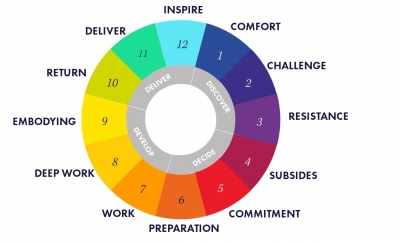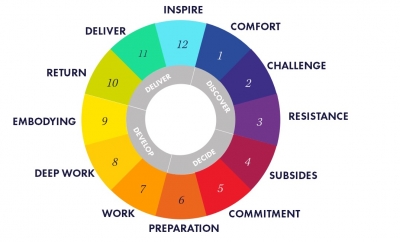Just before COVID-19 gripped the world, we published a book outlining the past, present, and future of HR called “HR (R)Evolution: Change The Workplace, Change The World.”
In that book, we described the seven great “P-waves” of progress in the discipline of HR since its inception in the 19thcentury factories of Northern England. We described some HR practices we felt probably would not become well established or widespread until at least 2025. But they are already happening.
Like many other crises before it, COVID-19 is an accelerator of change. We are living through 10 years of progress in three or four months. Everything is magnified, more intense, and more uncertain. But when the future is so unpredictable, how can any business bounce back from this crisis and be better than ever? The answer, paradoxically, is to look back to look forward.
We must become students of change. We must educate ourselves on the dynamics that drive change. If we can understand the 12 steps and 4 phases that individuals, teams, and organizations take when forced to change, then we can turn change from something threatening and unpredictable to something that can make us better. Change ultimately can help our companies grow in a more sustainable way and enable us to develop much closer, more meaningful relationships with our customers.
Figure 1: The 4 Phases and 12 Steps of Change

Change Phase 1: Discovery
Before COVID-19 hit, most companies were living in a relatively comfortable world, unaware of the fragility of their business or the inherent risks in the global economy. Companies’ financial reserves were too small and their levels of debt too high. So once COVID-19 forced a shutdown, many quickly got into cashflow difficulties. In some countries, such as the UK, the government stepped in with a furloughing scheme to support lower-paid workers on salaries of £30k or less. But there was nothing for the self-employed or higher earners, possibly because the latter group were believed to have personal reserves or resources that could buffer them through the crisis. In other countries, government help has been minimal. Poverty, unemployment, and economic hardship will hit such countries severely.
So COVID-19 effectively took many people and organizations out of their comfort zone, Step 1, into the discomfort that is Step 2. Some people or companies experience Step 2 as pain and panic, while others see it as a challenge or an opportunity. For the majority, the challenge has been painful. The natural human response to pain is to shut down or go into survival mode. Hence, stockpiling food or toilet paper. This is basically Step 3, where individuals or organizations resist the need to change. In fact, many companies have been simply talking about the need to survive, to wait it out until things can go back to normal. The talk of a “new normal” is really a desire for regression, or retreat to the comfort zone, albeit a slightly new version of normal.
Change Phase 2: Decide
The more enlightened organizations have realized that a bunker mentality doesn’t really solve the problems and resisting the need to change will not enable them to bounce back quickly once lockdown eases. They have reached Step 4, where the desire to retreat subsides. No, the only way to bounce back is to move forward and pivot your business. This rapidly leads you to the moment of truth: Step 5, where leaders, teams, and organizations must decide. The decision is to change: change how we have been working, how we relate to each other, and what we are doing. Without change, there will be no bounceback. But this change must be substantial. Tinkering around the edges will not cut it. In fact, the change required is massive and in line with the “once-in-a-lifetime” crisis we are facing. We must dramatically change our:
- Corporate strategies
- Corporate structures
- Corporate governance models
- Corporate cultures
- The way we assess and develop our leaders
- The way we relate to our customers
- The way we look after our people.
This is the HR evolution we wrote about in the book. Without that decision, there will never be any sustainable change. Any bounceback will subside and the V-shaped recovery will be U-shaped or possibly L-shaped. The level of commitment to change must be so significant that there can be no going back. Such change takes real courage, and only the best leaders and best companies will commit to such change. The ones that do will be the ones that flourish in the future. Once such a commitment has been made, companies will start planning for a new future with new balance and new meaning; this is Step 7.
Change Phase 3: Develop
All of this happens before the real work of change commences at Step 7. The work is for companies to become what has been called in the U.S., “deliberately developmental organizations” or DDOs. HRD will need to lead this change. The best probably will have already stopped being HRD and moved to become CHROs or even CPOs. But what they must become is CDOs: Chief Development Officers. People are the heart of every business and to bounce back after a crisis, individuals need to develop themselves. They need to get of the learning curves, let go of the obsession with skills and knowledge, and develop their ability to mature as adult human beings. In fact, adult development must become as critical to the organization’s future as financial discipline. This requires leaders to really work at it in Step 7 and do the deep work on their leadership shadow in Step 8. If they do, they will be changed for the better. Teams will evolve into mature leadership forces for good. And all this work must be locked into the company by truly embodying and consolidating the change in Step 9.
Change Phase 4: Deliver
Once leaders, teams, and organizations have step-changed themselves, they can return to their markets and customers, Step 10, and deliver at a whole new level, Step 11. This is a true transformation, a true revolution, that, if correctly executed, will inspire a whole new cycle of change: Step 12.
Dr. Alan Watkins is the CEO and co-founder of Complete and co-author of “HR (R)Evolution: Change The Workplace, Change The World.”

